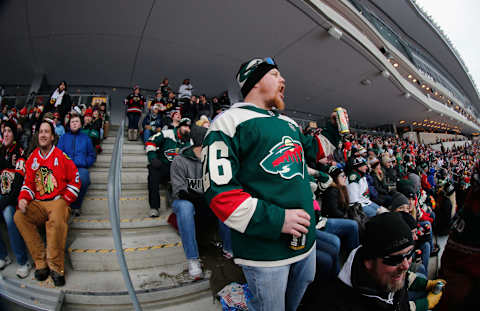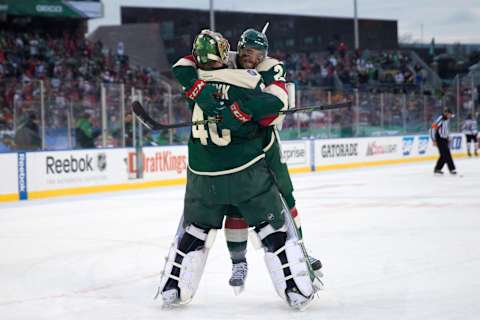Minnesota Wild: Three reasons Minnesota won’t get an outdoor game


Minnesota is regarded as the ‘State of Hockey’ by many; as such, you’d expect to see the Minnesota Wild hosting and competing in a lot more outdoor games. This isn’t quite the case.
With news that the Dallas Stars are being given an outdoor game in 2020, you have to wonder what the Minnesota Wild need to do to get one of their own.
There’s every chance that the Dallas game may see the Minnesota Wild in-action, especially given the history there between the (former) North Stars and the current Wild.
The NHL has insisted over the years of sharing the outdoor games around, not entirely fairly, but at least they’re not ignoring all teams outside of the North East completely. 23 of the league’s 31 teams have played outdoors at least once; the Minnesota Wild included.
Even so, you only need look at the fact that Central Division rivals, the Chicago Blackhawks have been featured six times to realise that the share isn’t exactly even.
In a game termed the Stadium Series in the 2016-17 NHL season, those same Blackhawks that always seem to be in an outdoor game, were downed 6-1 by the Minnesota Wild in front of 50,426 people at the TCF Bank Stadium in Minneapolis.
Unfortunately, despite a rich heritage of pond hockey and some incredibly strong college programs within the state of Minnesota, that is the only time we’ve seen the Minnesota Wild compete (at home or away) on outdoor ice.
The recent announcement of Dallas as a host leads us to think that Minnesota isn’t even on the radar of the higher-ups in the NHL when it comes to this outdoor spectacular.
In fact, you’d almost be forgiven for suggesting that we could see an outdoor game hosted by Las Vegas before we see a return of the contest to Minnesota. It certainly feels like this state is a rather forgotten spot on the NHL’s map.
There are of course good reasons why that is.
Obviously, the Minnesota weather lends to ice hockey outdoors, but there are most definitely financial and popularity factors at play; if the league is going outdoors, they want the most marketable encounters possible after all; we’re looking at the three key reasons preventing a Minnesota outdoor game.

The Minnesota Wild lack a marketable superstar element
Looking around the league at the teams that play host to outdoor games, there is a very clear pattern in that they have players that are marketable both to Canadian and to American audiences.
Take for example, the Chicago Blackhawks; Patrick Kane represents one of the best American-born players of his generation and Jonathan Toews is the epitomy of the hard-working Canadian hockey player.
The Pittsburgh Penguins are due to play their fifth outdoor encounter in 2019; one short of Chicago’s number. In Sidney Crosby, they have a player that has name value in any hockey circle, Canadian or American. Not only that, the supporting cast of Phil Kessel and Evgeni Malkin both offer marketable elements depending on the audience you wish to target.
More from Editorials
- Another Stanley Cup Final comes with the Minnesota Wild watching. When will that change?
- Story remains the same: Minnesota Wild flame out in first round
- Believe it or not: Minnesota Wild backs are against the wall, again
- The Minnesota Wild are in the postseason again. Is this the year they can make a run?
- Wild vs. Kings: Where does Minnesota go from here?
The Minnesota Wild, by comparison, lack any real obvious candidate to market a game around. Ryan Suter is stable and consistent but hardly a franchise name. The team captain, Mikko Koivu isn’t exactly a huge name in his home country, let alone in North America. Mikael Granlund has been labelled by some as a superstar, but again, he’s rarely spoken of outside of Minnesota.
I think the only player that holds the level of marketable appeal you need to sell an outdoor encounter is probably Matt Dumba. He’s young and talented, as well as being a name regularly heard in the Canadian media, courtesy of the endless rumours trading him away.
If an outdoor game is a target for the Minnesota Wild brass, they need to find some superstar talents that not only can bring a strong game on the ice, but can be more than just steady and safe as marketable presences off the ice.
Since the original expansion draft that birthed the first Minnesota Wild roster, they’ve always lacked a true big name; Marian Gaborik carried the mantle for a while, but even he is at best second-tier when you think of the superstars that have passed through the league since his time with the Wild.
Unfortunately, this superstar element is going to have to likely come from the draft and to find a Patrik Laine, Connor McDavid, Auston Matthews or Jack Eichel; you’re looking at the top two or three spots – not exactly much fun for the fan base watching your team heading that leaderboard.

There isn’t a clear marketable rivalry to showcase the Minnesota Wild
Of the rivalries showcased over the years, we’ve seen the the Pittsburgh Penguins and Washington Capitals face off, we’ve seen all manner of Original Six rivalries re-visited and the San Jose Sharks and Anaheim Ducks take on the Los Angeles Kings.
That’s literally just scratching the surface too; the Montreal Canadiens and Boston Bruins’ rivalry dates back generations, likewise that between the Bruins and Chicago Blackhawks. The Philadelphia Flyers taking on the Penguins is perfect for marketing, likewise the Colorado Avalanche’s game with the Detroit Red Wings had plenty of history and animosity to build on.
All of these rivalries make it easier to market the game; build on what is already there and then tack on the outdoor element to make it even bigger.
In fact, possibly the one surprise when you look at the list of outdoor games is that the historical rivalry between the Montreal Canadiens and Toronto Maple Leafs hasn’t yet been showcased, nor that of the Calgary Flames and Edmonton Oilers.
Both are very much marketable in a Canadian marketplace, but possibly lack that little extra needed to generate successful television ratings in the United States.
In terms of rivalries that the Minnesota Wild have, given they’re just 20 years old; you’d have to look at the Dallas Stars purely because of the history of that franchise. If the roots of the Texas team weren’t in Minnesota, this would be an non-starter. That history alone though does make me think that the Minnesota Wild might be hosted outdoors down South in 2020.
Beyond that rivalry, any of their Central Division adversaries is probably fair game; the Chicago Blackhawks and St. Louis Blues would make for perfectly reasonable opponents. In fact, given the propensity of the NHL to give the Blackhawks outdoor games, maybe that should be the sales pitch!
The one I’d most like to see is a more recently forming rivalry; that between the Wild and the Winnipeg Jets. Recent play-off history between the two sides and the fact you could sell the came on a USA versus Canada angle could make it marketable.
However, as you can see; when you’re trying to stretch a nation versus nation angle to make a rivalry more marketable, it’s probably not the one that the NHL will be picking for national exposure.

The Minnesota Wild don’t really represent a growth market
Plain and simple; hockey is embedded in Minnesota already. There is no value to the NHL in growing the game within the state, hence why the Minnesota Wild are consistently overlooked.
In selecting Dallas to host an outdoor game, Gary Bettman and company are making it clear that they wish to market the game further and further South and that realistically they don’t look set to gain anything by hosting these games in the North.
Every year, of course, we do see one game typically hosted in Canada or at least close to the border, but they equally are games that don’t offer much more than match-day revenue.
By hosting games in non-traditional hockey markets, the NHL is hedging their bets on further growth which long-term means more bums in seats. Somewhere like Minnesota already has no issue filling seats, regardless of how the Minnesota Wild are performing.
In fact, just look at recent events where we’re seeing the NHL shipping teams off to China and Finland to play games as a sign of how majorly they want to target growth in places that typically aren’t viewed as NHL markets.
There really is very little that the Minnesota Wild can do to fix this dilemma either. Hockey is part of the state of Minnesota and will remain so, it just takes the NHL head office to realise that this fact alone makes marketing an outdoor game very easy.
Simply sell an outdoor game on hockey tradition in the state, build on the pond hockey culture and ignore the fact that the market doesn’t need growth.
Smart business?!
It really depends how you look at it.
If you want to look at it as rewarding a community that loves the game; it’s a win every day of the week.
If you want to look at it as a place that has likely already reached peak saturation in terms of building a fan base and long-term future of the sport, you’re not looking at a smart business strategy.
dark. Next. Eriksson Ek should seize chance with Iowa
Sad as it is, I don’t think an outdoor game is headed this way anytime soon. The only way the Minnesota Wild will be skating on outdoor ice is in someone else’s state.